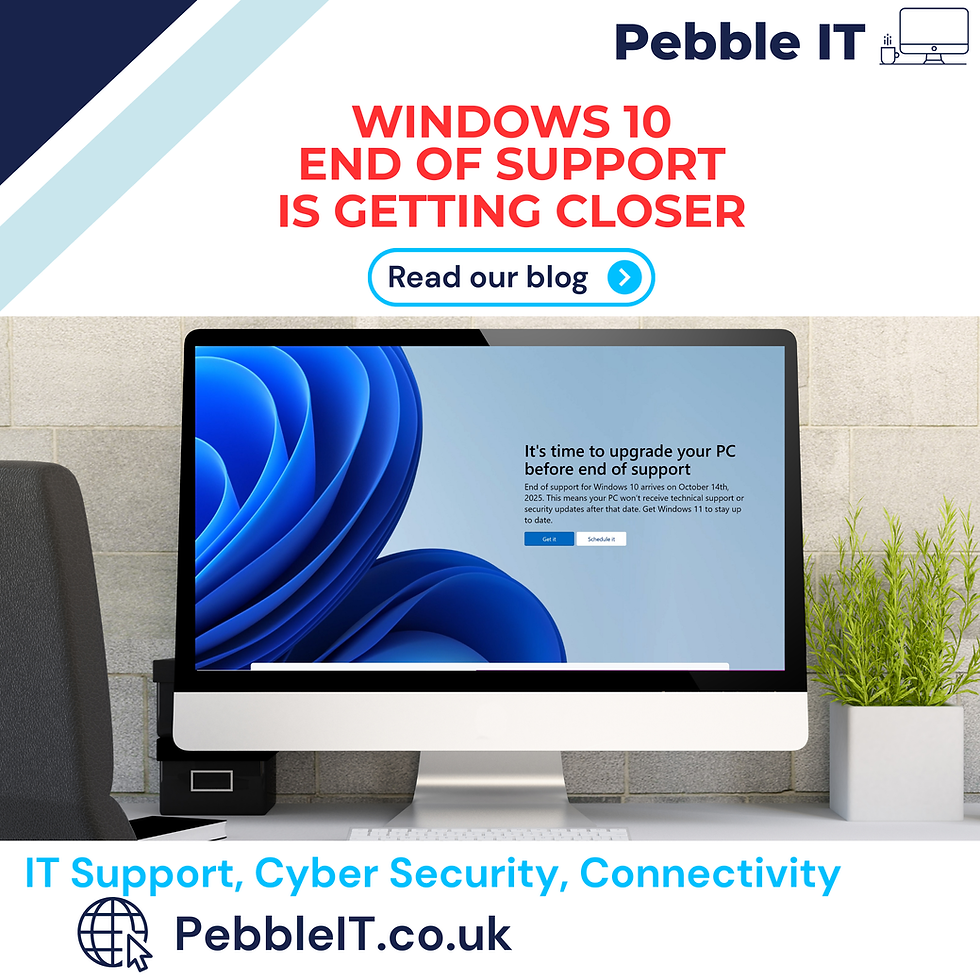Windows 10 End of Support: Timeline, Implications, and what your Business should do next
- Jason Patey
- Apr 28
- 3 min read
Microsoft officially announced that Windows 10 will reach its end of support on October 14, 2025. While that may seem a long way off, the reality is businesses must start preparing now to avoid security risks, compliance issues, and unexpected costs.
In this post, we’ll cover the key dates, what "end of support" really means, and what your business options are.

What Does End of Support Mean?
When an operating system reaches its end of support, Microsoft stops providing:
Security updates and patches
Bug fixes
Technical support
Without regular updates, devices become highly vulnerable to cyberattacks, malware, and operational failures. For businesses that need to stay compliant with standards like GDPR, PCI-DSS, or ISO 27001, continuing to use unsupported software can also lead to hefty fines and reputational damage.
Windows 10 End of Support Timeline
Here’s a breakdown of what to expect:
Now until October 2025:Windows 10 continues to receive monthly security updates. This is the time to plan your migration.
October 14, 2025:End of official support for Windows 10. No more security patches, bug fixes, or new features.
Post-October 2025:Microsoft may offer paid Extended Security Updates (ESUs), similar to what they did for Windows 7 — but this is costly and only a short-term solution.
What Are Your Business Options?
Businesses have a few clear options to consider:
1. Upgrade to Windows 11
Best for: Most businesses with modern hardware.
Why: Windows 11 offers a more secure, modern platform with continued support and feature updates.
Requirements: Check that your hardware meets Windows 11 minimum specs, including TPM 2.0 and Secure Boot capabilities. (Many devices purchased after 2020 will qualify.)
2. Replace Outdated Hardware
Best for: Businesses with older devices that can't upgrade.
Why: Investing in new, Windows 11-ready hardware ensures long-term stability, performance, and security.
3. Explore Cloud PC Solutions
Best for: Flexible, remote, or hybrid workforces.
Why: Solutions like Microsoft Azure Virtual Desktop or Windows 365 allow you to stream a Windows 11 experience securely to almost any device, even older hardware.
4. Use Extended Security Updates (ESU) – As a Last Resort
Best for: Critical legacy systems that can't be upgraded yet.
Why: ESUs can buy extra time, but they are expensive and only postpone the inevitable need to move away from Windows 10.
Steps Your Business Should Take Now
Audit your IT environment: Identify all devices running Windows 10 and assess hardware compatibility for Windows 11.
Develop a migration plan: Create a clear timeline and budget for upgrading or replacing devices.
Communicate with your team: Make sure your staff are aware of upcoming changes and provide training if necessary.
Work with a trusted IT partner: An experienced Managed Service Provider (MSP) can help you plan and implement the transition smoothly.
Prioritize cybersecurity: Ensure that, during the transition, your systems stay protected with updated antivirus, endpoint detection, and backup solutions.
Final Thoughts
October 2025 may seem distant, but upgrading your business from Windows 10 is not a task to leave until the last minute. Early planning will minimize disruption, reduce costs, and protect your business from avoidable security risks.
If you'd like help assessing your current setup or planning your upgrade strategy, now is the time to start.
How can we help?
Pebble IT has extensive experience in working with businesses to ensure they have the correct cyber security tools, and to create these important IT strategies, working with businesses to introduce IT training.
If you would like a friendly chat on how we can help you with your IT requirements or want to find out more, please reach out at hello@PebbleIT.co.uk or contact us on the website.



Comments